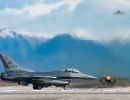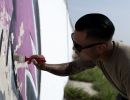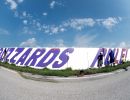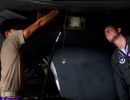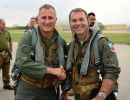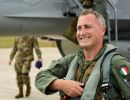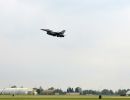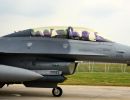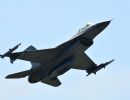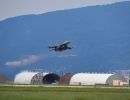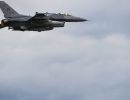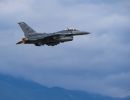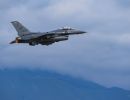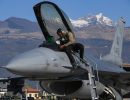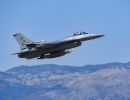One thing Saddam won’t dare do, though, is fly his military aircraft north of the 36th parallel, which the United Nations declared a no-fly zone in 1991. If he does, the Iraqis will undoubtedly lose any warplanes venturing past that figurative and literal line in the sand. For example: an Air Force F-16 Falcon on patrol in 1993 downed an Iraqi MiG-23 fighter after it entered restricted airspace.
Ensuring similar violations don’t occur again is Operation Northern Watch, a combined task force that monitors Iraq, ensuring it complies with U.N. Security Council resolutions. Plus, Operation Northern Watch, located at Incirlik AB, Turkey, contains Saddam’s regime, which has shown no qualms about slaughtering fellow countrymen in past incidents.
The combined task force consists of roughly 1,500 coalition members and 50 aircraft, including U.S. F-16s, F-15 Eagles and Strike Eagles, EA-6B Prowlers, KC-135R Stratotankers, HH-60G Nighthawk helicopters, HC-130 Hercules, C-12s, and E-3B Sentry Airborne Warning and Control Systems. Turkish F-4s, F-16s and KC-135s, and British Tornadoes, Jaguars and VC-10 Tankers round out the unit.
 Additionally, Air National Guard and Air Force Reserve Command troops have joined the contingency’s mix to relieve active-duty units squeezed by today’s operations tempo pressure.
Additionally, Air National Guard and Air Force Reserve Command troops have joined the contingency’s mix to relieve active-duty units squeezed by today’s operations tempo pressure.
“We truly are a total force unit,” said Brig. Gen. David A. Deptula, Operation Northern Watch Combined Task Force commander. “We have every element that is required to respond to any kind of threat that the Iraqis present.”
The 1,000 U.S. Air Force airmen deployed to this multinational operation fall under the 39th Air and Space Expeditionary Wing — a model for tomorrow’s Expeditionary Aerospace Force — which is overlaid onto Incirlik’s permanent 39th Wing. The 39th Wing’s commander, Col. Dutch Remkes, controls 39th ASEW aircraft and is tasked with organizing, training and equipping all U.S. Air Force forces participating in Northern Watch. This chain of command allows for clear-cut lines of administrative control.
“In years past, when we had a provisional wing here, there was sort of an ad hoc command relationship,” said Col. Gary Baldwin, operations group commander for both the 39th Wing and the 39th ASEW. “Now, when an Air Force unit deploys here, whether it be a fighter, tanker or AWACS, they deploy as an expeditionary squadron and report through me to the wing commander.”
Activated on Sept. 15, 1997, the 39th ASEW provides a glimpse of 10 air expeditionary forces scheduled to stand up by Jan 1, 2000. These will be light, lean and lethal wings comprised of fighter units supported by people, including reserve forces, and equipment from bases around the world.
Moreover, each AEF will be tailored specifically to a contingency to support a warfighting commander in chief. Deptula called this the “flexibility” of an expeditionary aerospace force.
“It provides us,” he said, “a means to task organize forces when meeting an objective. It allows us to match what we need in a particular situation.”
For Operation Northern Watch, it means constructing a joint and combined air expeditionary force, which places U.S. airmen, soldiers, sailors, Marines and civilians alongside the British Royal Air Force and Royal Army and the Turkish army, navy and air force at Incirlik.
Less than an hour after launching from the base, located just outside Adana on Turkey’s southern border, allied aircrews enter Iraqi air space. Flying approximately 40 sorties a day, they enforce a no-fly zone established in 1991 after Hussein’s military, using napalm and chemical weapons, attacked Iraqi Kurds.
 Deptula, who was the principal planner for the coalition offensive air campaign during Desert Storm, believes when such a multinational air expeditionary force is formed, adeptness is what decides which units are used and how.
Deptula, who was the principal planner for the coalition offensive air campaign during Desert Storm, believes when such a multinational air expeditionary force is formed, adeptness is what decides which units are used and how.
“Capability is what is important when conducting a military operation,” the general said. “In the Gulf War, I didn’t care if an aircraft came from country A, B, C or D, or the Army, Air Force, Navy or Marines. I was interested in what kind of capability that ‘asset’ provided to the plan.”
Adding to Deptula’s words, Gen. Michael E. Ryan, Air Force chief of staff, said future U.S. air expeditionary forces will seldom “engage alone.” Instead, it will be partnerships like the one at Incirlik.
“As we have seen in the past 50 years,” Ryan said, “it has been allies and friends who have given strength and resolve to coalition actions. For it is when peace and stability fail that our forces will be called on, and expected to be first to respond, first to fight and first to win.”
Such was the case on Dec. 28 when Operation Northern Watch aircraft struck a surface-to-air missile site after Iraqi forces fired on an Air Force F-16. Acting in self-defense, coalitions aircrews answered back with AGM-88 HARM and precision-guided munitions.
Afterwards, President Bill Clinton said: “Our pilots have the authority to protect themselves if they’re threatened or attacked. They took appropriate action in responding to Iraqi’s action.”
And referring to the operation at Incirlik, the president added that the no-fly zone has been and will remain an important part of “our containment policy.”
“Because we effectively control the skies over much of Iraq,” he said, “Saddam has been unable to use his airpower to repress his own people or to lash out at his neighbors.”
With Hussein continuing his dangerous games of cat and mouse, the Air Force, undoubtedly, will have to keep a Northern Watch.
Keep a Closer Watch
In the article “A Northern Watch” (February 1999) you have the wrong airman and aircraft model in one photo caption. It should have read, “Senior Airman Kirby C. Haskins from Aviano Air Base, Italy, inspects an AIM-9 missile before takeoff at Incirlik Air Base’s flightline. His squadron, the 510th Expeditionary Fighter Squadron flies the F-16CG aircraft in Airborne-Forward Air Control missions.”
Senior Airman Kirby C. Haskins
Aviano AB, Italy


























